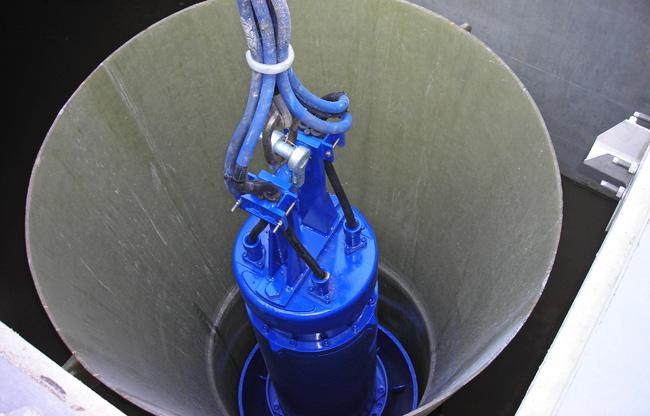Different Types of Pumps – Submersible Pumps
Submersible Pumps
Submersible pumps are a particular type of centifrugal pump designed to function with the pump and the motor completely submerged in the process media. The motor will of course be sealed in a way that prevents any ingress of the media from seeping into the motor casing and causing the motor to fail.
Since submersible pumps do not use a motor above ground, floor space can often be better utilized, and the overall cost of the installation may also become reduced. These type of pumps also tend to have lower maintenance costs and create less noise than pumps which have the motor mounted above ground. Due to the fact that the pump is submerged, there are of course no issues with pump priming.

Principle of Operation
The exact type of motor and pump required in any particular application circumstances will of course differ. In principle, there are two primary types of submersible pumps installations.
There are those that operate down a bored well system and those that operate in a sump, wet well, or basin.
The type that operates in a bored well normally includes a very thin and manoeuvrable submersible motor located at the bottom of the pump. Just above the motor will be an inlet screen and a suction bell. This will direct the fluid into the centrifugal pump stages consisting of impellers and diffuser bowls. Usually these pumps are multi-stage, i.e., have more than one impeller and diffuser, so they can be used to pump fluids from very deep wells.
Flows for both types range from less than 10 gallons per minute for a residential version, to several thousand gallons per minute for irrigation, industrial, or municipal applications.
Submersible pumps are normally used to handle clean or dirty water or are often deployed on sewage plants. For these applications, cast iron or ductile iron construction is quite commonplace. For less onerous applications such as domestic or lighter duty sump or utility pumps, the pump casing will often be of plastic construction. For corrosive or abrasive applications theses pumps are also available in more exotic materials.
Click on the following links to learn about other types of pumps:
How do centrifugal pumps work?
How do positive displacement pumps work?
How do peristaltic pumps work?
How do magnetically coupled pumps work?
Typical applications
Submersible pumps can be found in a huge variety of applications. The type that operates in a well is also used for drinking water supply, irrigation, dewatering, and in oil production.
The type that operate in sumps, pits, wet wells, or basins is normally used to pump wastewater, which might be from groundwater that seeps into homes and other buildings, floor and equipment drains in a building, This type is also used in other applications, including pond pumps and industrial pumps in plants.
Submersible pumps generally operate across the following ranges:
- Flow rate ranges between 20 to 28000 lpm
- Total head (pressure) ranges between 0.4 to 6 Bar
- Horsepower ranges between 1 to 250 hp
If you have any questions in response to this article then please get in touch, email us at [email protected] or give us a call on +44 (0) 8707 66 77 78.
Get the latest process industry news
Interested in receiving even more industry-leading news from Process Industry Forum delivered directly to your inbox? Then sign up to our free newsletter. Bringing you the latest news, trends, innovations and opinion from across the process industry, our exclusive newsletter gives you all the industry insights of the moment in one, easy-to-digest bulletin. Stay ahead of the competition with regular process industry news instalments from PIF.

